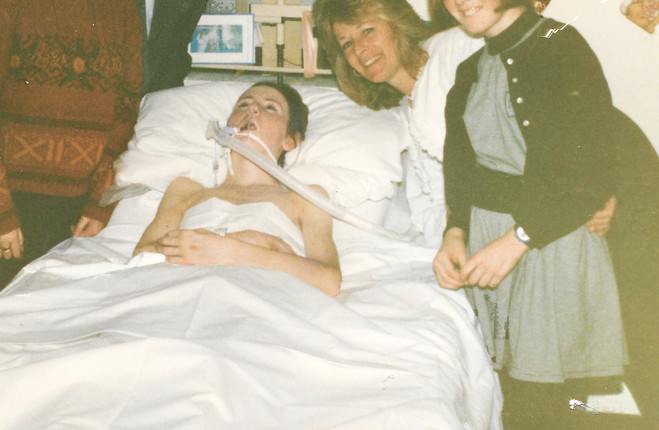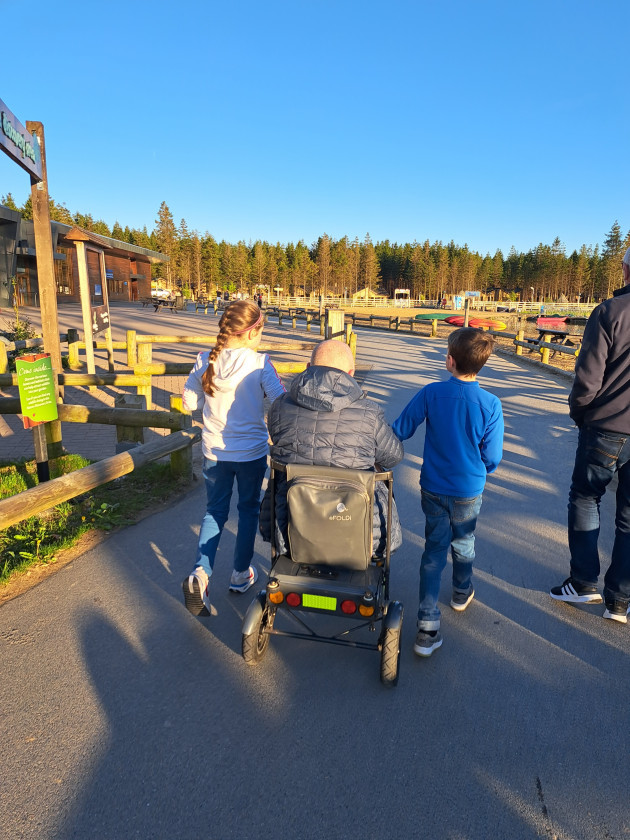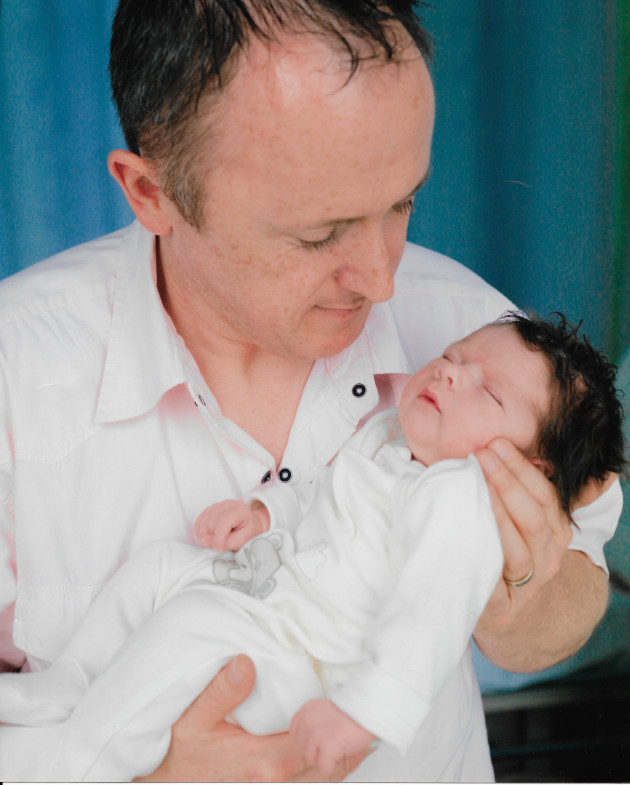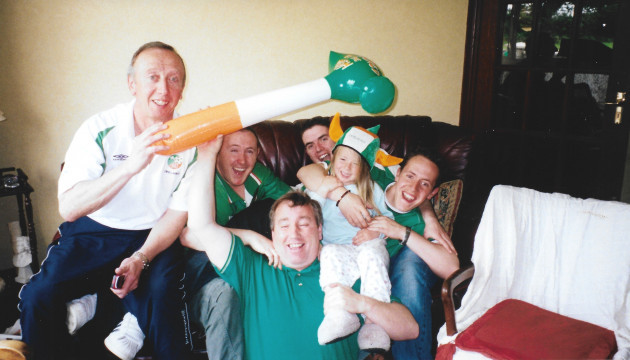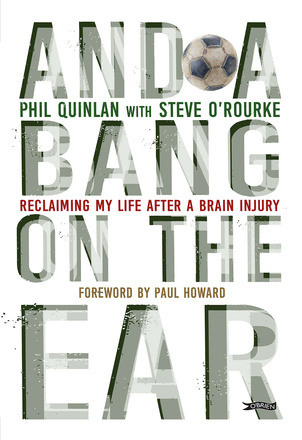PHIL QUINLAN will turn 50 next year.
For over half his life, he has been physically disabled.
One of the many challenges of being in this position is dealing with the habitual insensitivity of other people.
“I’m up here now at my son’s hurling training,” he tells The 42. “And there are people parked in the disabled parking spots that shouldn’t be there and it’s a major bug bearer of mine. And people either just don’t think or aren’t bothered.”
Not everyone, Quinlan adds, knows how to act appropriately around a disabled person.
“When I’m using my power chair, I’m the best in the world. They approach me: ‘Do you need a hand, is everything okay?’ But when I’m walking like a drunk, they think: ‘Stay with me, don’t stare son, don’t stare. You might catch the disability off him.’
“I know that’s bringing it to a whole new different level, but that’s how I used to feel. I’m very angered by those attitudes.
“So the best icebreaker I can find is humour. I’m self-deprecating. It makes a lot of people think: ‘If he’s okay slagging off himself, then we’ll tread a bit better with him.’ I find once people are comfortable with humour, that they’re comfortable with disability.
“I find that if I have a laugh at myself or laugh with somebody else, it’s like a big weight lifted off their shoulders.
“People can’t try too hard. I understand if they’re embarrassed or uncomfortable. But if they make the approach and they come up to chat, it’s huge. So I’d have to put them at their ease.
“Once I make them comfortable, I feel like I’ve won sort of a game if you like. And they go away with a positive reflection of me and disabled people hopefully.”
Quinlan has turned the story of his slow, painful and ultimately ongoing recovery from a life-threatening injury into an inspirational memoir, co-written with Steve O’Rourke, formerly of The 42.
Its title, ‘And a Bang on the Ear,’ refers to a fateful Sunday morning in 1989. Quinlan was playing a game of football and was involved in a clash of heads. The injury initially was thought to be innocuous and treated as such. However, after Quinlan fell asleep on the sideline and blood started to trickle down his ear, it was only then that the seriousness of the situation became apparent.
“I think 33 years ago I’m not even sure concussion was invented,” he says. “So it was a laugh back then. I was thrown into the dugout and let fall asleep.
“I think these days, education is so much better, medicine is so much better. And if it happened yesterday, I’d be in a much better position. But back then, the laugh that it was: ‘Oh he banged his head, let him fall asleep, he’ll be grand.’
“It was the perfect storm because the fog was intensely bad that day. The driver of the bus couldn’t overtake because it was too dangerous to overtake. So what would be a 10-minute journey usually was a 45-minute journey. And then when I got to Navan Hospital, I was in and out of consciousness.
“I think it’s called talk-and-die syndrome, where I was talking and then I was falling asleep for a bit and I was coherent enough, I believe. And until the ambulance arrived, and the nurse accompanied me, I got progressively worse on the way to Beaumont. I presumed they were sending me to Beaumont just as a precaution but if they had sent me home that night, I wouldn’t be here today talking to you.
“And when I arrived in Beamount, I arrested and luckily enough, there was a resuscitation team around me. And the CAT scan then showed a massive clot.
“I met the neurosurgeon there, it must have been four or five years ago. And to me, he’s God. But he said it wasn’t a very difficult operation, which I was blown away with because he talked as if he was using his Black and Decker and then his Nilfisk to hoover out the hematoma.”
Quinlan fell into a coma after the accident and was given a 25% chance to live. Six weeks later, he regained consciousness.
“These days, I wear it as a badge of honour. Because I met a porter in Beaumont Hospital about 10 years ago when I dropped a friend off for some tests. I remember the porter from the Richmond Ward used to bring me down to physio. He didn’t remember me and I told him I was in the Richmond Ward and he looked at me with his Dublin accent and said: ‘Jaysus, you did well, there are not many fuckers that left the Richmond Ward alive.’
“So that was the real brain injury ward up in Beaumont. So I’ve done well. I suppose when the pains were immense, with my back pain in 2001, I felt very sorry for myself. There was an awful lot of self-pity, which was probably the time to do it because these days with kids, you can’t dwell on self-pity anymore.
“What I put my parents through, I didn’t realise it until I had my own kids because I honestly don’t know what way I’d react if anything serious happened to Eileen or Joe.
“What my mother must have thought when she was told that I had a 25% chance of living. What that did to her, it must have killed her. I have talked to her about it and she looks back now, same as myself: ‘Haven’t I done well.’ But it must have been cruel what I put them through, my poor parents. And I’ll never stop thanking them for it.”
An avid athlete, Quinlan has had to grow accustomed to a very different lifestyle and identity since the accident.
“The initial pains and frustrations were absolutely massive. Going from being the fittest guy in Navin, one of the fittest guys in Meath, having run in Cross Country Championships, to suddenly being bedridden for the course of two-to-three months, and then having to learn to walk again.
“I always believed I would get back because the surgeons said to Mom across my bed: ‘Two years.’ And I thought: ‘Ah yeah, I’m only 15-16, I can last another two years, and then I’ll be able to run the Dublin Marathon for my 18th birthday. I’ll be able to run with the bulls in Pamplona, I’ll be able to climb Machu Picchu.’
“But I missed the final part of the sentence in brackets: ‘Before we reassess.’ In my head, I never heard that until about 10 years ago maybe. There was always a sliver of hope that I would be ‘cured’ if you like through a miracle in Lourdes or somewhere like that. But every year it gets slimmer and slimmer. And the pains get greater and greater because age is degenerative, the brain degenerates pretty quickly when you get to my stage. I’m going to be 50 next year, which is a huge milestone.
“To be honest, I’m just glad to be here. It’s great to be able to watch the kids training and playing. That never even entered my head, you know, having kids and getting married.
“I was happy enough by myself. I was going to be the hermit, the monk, just a happy-go-lucky guy. But it all changed. And I’m a dad now and it’s just incredible to think where I’ve come from, to kids and even having my wife to a certain degree. Whereas 20 years ago, I was struggling to look after myself. It’s been a huge turnaround.”
The degree of pain Quinlan suffers from has fluctuated over the years.
“From ’96 I suppose, there were no pains until 2001. And then in 2001 after walking back from work to my apartment at the time, I went downstairs to watch Liverpool versus Newcastle. I sat down too quickly, too awkwardly and bang, something went horribly wrong in my back.
“And I’d always been pragmatic enough to think and to know that someday something was going to go wacko. And I’d have to learn to deal with it.
“I had four years of chronic back pain, which for somebody who was fully able-bodied, it would have been hard enough to cope with. But with my very awkward gait, every swing of my right leg was like a stabbing pain in my back.
“I suppose since I’ve not really recovered from that as much. I haven’t travelled as much. Because from ’96 to 2001, I travelled the world and 2001 really put a stop to it.
“But it’s only since I started using the power chair that I got two years ago, travel has opened up immensely to me now and I love it because I love being able to bring the kids. I cycle down Champs-Élysées as they hold my hands. Paris has always remained very close to my heart. We’ve [also] been to Amsterdam, Spain, and Edinburgh with this power chair, so it’s opened up a brand new lease of life for me.
“And when the kids walk along beside me holding my hand, it’s huge. And I don’t have to concentrate on staying up because I have this power chair. And it’s massive because every step to me is like a cauldron, it’s volcanic, it could go either way. I’m always ready for the fall.
“I’m very comfortable with it now 33 years later. The pains are still here but they’re managed an awful lot better, and having kids, they’re a huge distraction from the pain.”
While no longer able to participate, Quinlan’s passion for sport remains as fervent as ever.
“I’m probably preferring rugby now to soccer strangely enough. But any match that’s on at all, it comes down to the fact that I’m sitting in my chair looking out. I have a lovely bay window, which comes out onto the green.
“And whenever I’m caught looking out the window, [my wife] Helena comes in and says: ‘Okay, who’s playing now, are they any good?’ I watch the kids playing and I’m hoping that one day a superstar will come from that green area so I’m just looking out to see what sort of skills they have.
“Coping with the pain is frustrating, but I’m not in pain all the time, it’s only when I walk. So I can sit down and there’s relief.
“And I just love sport. I think it’s been incredibly good to me, despite what it has taken away from me.”
Notwithstanding the cost of the injury both literally and figuratively, Quinlan has never received any financial compensation for his troubles.
“I made murmurings a few years ago,” he explains. “I wanted to find out what the insurance schemes are like these days that the FAI should probably insist on but the person that I was in touch with couldn’t find any details for me from 1989-90, to see what the insurance schemes were like back then just to compare them.
“I wasn’t after anything, I know the statute of limitations is long gone. But I was after information and they couldn’t provide it even then.
“I got nothing, but then looking at it a different way, if had got a lot of money, we’ll say hundreds of thousands back then, I might not have had the same drive as I had afterwards. I might have rested on my laurels, I might have bought a house or lived in a nursing home. Who knows what would have happened if I had got a lot of money back then?
“But the fact that I got nothing probably drove me on to work for myself. Everything I have now, I paid for, like a mortgage, I think there are about 20 years left on it. There are about six months left on the car loan. But I’ve seen people, not relax, but maybe fold up, because they got the money.
“It did leave a very sour taste in my mouth that the FAI never got in touch, nor the referees’ association. I’m not even sure if the match should have been played. The fog was so bad, you couldn’t see in front of you.
“So that’s my feeling on that now. I’m over it, but it still leaves a sour taste. Because these days we’re trying to save for a downstairs bedroom because coming downstairs is so lethal for me. And in the event of anything happening if there’s an emergency, I’m going to be the last man falling down the stairs.”
While there is plenty of pathos in Quinlan’s story, it is inspirational too in the way he dealt with such a dire situation and recovered to the degree that he could live a relatively normal life.
These days, he works in palliative care at St Mary’s Special School in Navan, which provides a sense of perspective and serves as a reminder that there are people much worse off than him.
“The kids that I work with, their level of disability is severe and profound. So they probably never walk, talk or eat. They have been fed through NG tubes. And it’s just incredible to get even the smallest smile out of them. It could take four years to get any better feedback. But I suppose I’m very empathetic that way — I can observe them, sit beside them and sometimes sit on them and have a laugh with them, try and find out what makes them tick.
“The main school, it’s helter-skelter. The kids are not very physically disabled, they’re running around, causing riots, they’re teenagers, these kids I work with now in the special care unit, they’re fantastic.
“It’s such a level that I can bring myself up to their level, and just get into their head. Because I’ve seen what they’re going through. There is one lovely teenage guy, who I see an awful lot myself in when he has his seizures. I see: ‘Right, this is what happened. This is what it was like, this was the panic that Mom had with me back in the day in Beaumont Hospital.’ She harangued the doctors into giving me more medication.
“It’s wonderful to work in the nursing unit with the nurses and the teachers, and just to see the kids thrive.
“They don’t want anything. They just want to be taught little bits and pieces, they just want to have a laugh, it brings home an awful lot. Kids on the outside want their Playstations and XBoxes. These kids just want to be loved. They just want the basics. And I think we can give it to them because the team in the school and in the specialty unit, it’s probably the team that I’ve always wanted to be on.”
Quinlan wrote down his story primarily for Eileen and Joe, his children, “to leave them a legacy”.
Nonetheless, seeing the book become a best seller on the Irish Sports Books charts has been “a dream come true”.
“If any disabled punter is reading it and sees what I’ve done, they’re thinking: ‘Fuck me, I could probably do it as well myself if I get off my bum,’” he adds.
“Because there are a lot of people that do. And because I was so young, it probably helped immensely. It steered me in the proper way. If I got the same injury at 20 or 30, I wouldn’t have had the same wherewithal to make a comeback. Because I’d say my bouncebackability would be next to nil. Whereas back in the early ’90s, there was nothing, only Mom and Dad’s tough love, to drag me through this journey.
“So I suppose that’s the legacy I’d like to leave — [to show that] even through the pain, there’s always sunshine at the end.”
‘And a Bang on the Ear: Reclaiming My Life After a Brain Injury’ by Phil Quinlan with Steve O’Rourke is published by O’Brien Press. More info here.
